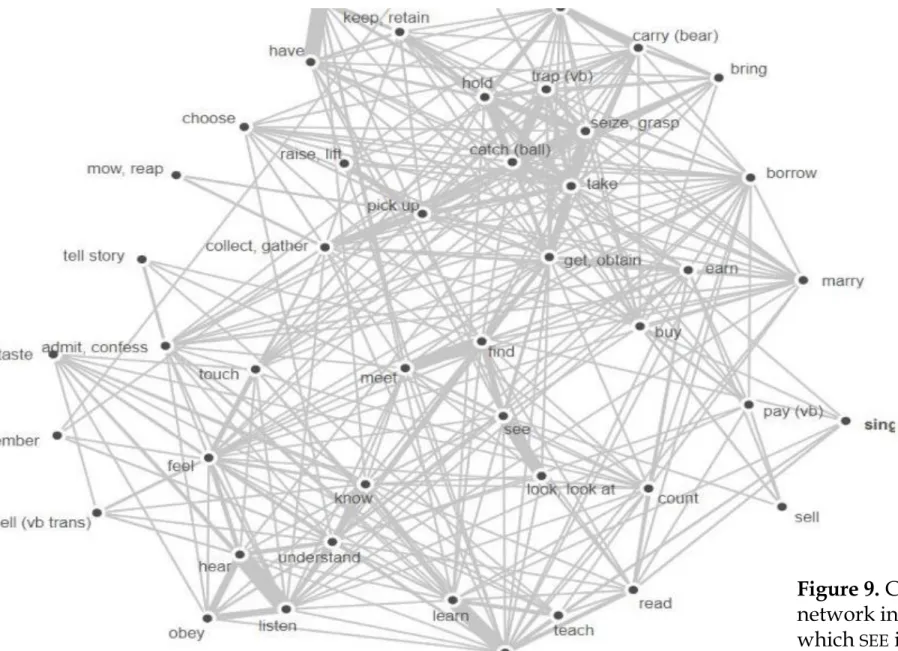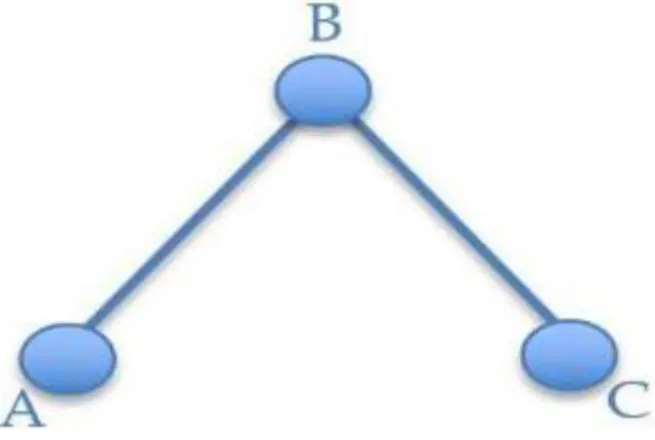+
Weighted lexical semantic
maps for areal lexical
typology
Verbs of perception and cognition as a case study
Thanasis Georgakopoulos
(University of Liège)Eitan Grossman
(Hebrew University of Jerusalem)
Stéphane Polis
(F.R.S.-FNRS / University of Liège)
in collaboration with Dmitry Nikolaev
(Hebrew University of Jerusalem)
+
Outline of the talk
Semantic maps
What are semantic maps?
Why use semantic maps for areal lexical typology?
Case study: verbs of perception and cognition
Why is this semantic field interesting? The datasets
CLICS
Vanhove (2008) WORDNET
Areal patterns and general discussion
+
Introduction
Semantic maps
+
Semantic
maps
4
Figure 1. A semantic map of typical dative functions /
the boundaries of English to and French à
(based on Haspelmath 2003: 213, 215)
+
Semantic maps
5
Weighted semantic maps
Figure 2a. A simple semantic
map of person marking(Cysouw 2007: 231)
Figure 2b. A weighted semantic
map of person marking(Cysouw 2007: 233)
+
Semantic maps
6
Lexical semantic maps
Figure 3. Overlapping polysemies:
Eng. straight vs. Fr. droit
(François 2008: 167)
Colexification = multifunctionality Languages differ as to which
+
Semantic maps
7Weighted lexical
semantic maps
Figure 4. Semantic map for time-related senses based on the CLICS data
+
Semantic maps
The map makes universal claims
Frequency: attested vs. non-attested and frequent vs. rare
Types of polysemy: possible vs. impossible
Implicational hierarchies (unlike other colexification networks)
The mapping of
language specific
items allows
studying genetic, areal, and culture specific patterns,
but it also shows how hard it is to reach statistically significant
results
8
+
Verbs of perception and
cognition
A case study
+
Why perception & cognition?
Perception and cognition are among the
basic concepts
that are
lexicalized in the languages of the world (e.g. Swadesh 1952)
Well-studied
domain: our results can be compared (e.g.
Sweetser 1990; Evans & Wilkins 2000; Vanhove 2008)
The relevant literature has revealed both
universal and
culture-specific patterns
+
Verbs of perception & cognition
11
Interfield (= Interdomain/ Transfield)
(senses: different semantic field)
Semantic extensions
Intrafield (= Intradomain)
(senses: same semantic field)
+
Verbs of perception & cognition
12
Figure 4. Viberg‘s sense modality
hierarchy for semantic extensions and polysemies of perception verbs
(Viberg 1984: 136)
Intrafield extensions
Table. Inventories of the verbs of
perception
+
Verbs of perception & cognition
13
Figure 6. The structure of our metaphors of perception
(Sweetser 1990: 38)
Mind-as-body-Metaphor:
• Common cross-linguistically (if not universal):
the connection between VISIONand KNOWLEDGE
(Sweetser 1990: 45) The internal self is
understood in terms of the bodily
external self
(Sweetser 1990: 45)
+
14The culture sieve:
• “filters” those elements that are in
accordance with the premises of a given culture
• “impregnates” the mapping with touches of a culture in contrast with other cultural and social systems
(Ibarretxe-Antuñano 2013: 324)
Extensions in cognitive verbs:
• A foot in culture: a relativistic aspect
(cf. Sweetser 1990)
• A foot in nature: a universal aspect
(Evans & Wilkins 2000)
In Australian languages:
(Evans & Wilkins 2000)
• Cognitive verbs > ‘hear’ (cf. intrafield extensions confirm the prevalence of vision)
Figure 7. The culture sieve (Ibarretxe-Antuñano 2013)
+
More recent accounts
15
Vanhove 2008
•
Sample of 25 languages (8 phyla);
mostly African
•
Intrafield
: vision prevails
•
Transfield
: the auditory modality
prevails
•
Stronger semantic association
of hearing and mental
perception
•
Implicational universal
:
•
Hearing > vision > prehension
[no distinction between controlled activity (e.g. listen) vs. non-controlled experience (e.g. hear);
+
More recent accounts
Wälchli 2016
16
•
Convenience sample
: Central, East and North European languages
•
Case study
: Auditory and visual perception
•
Explorative perception verbs = controlled activity (e.g. listen)
•
Opportunistic perception verbs = non-controlled experience (e.g. hear)
•
Specific perception verbs: subtype of opportunistic perception
verbs
•
Goal
: how the encoding of a specificity distinction may differ
cross-linguistically.
•
Particular areal feature for Baltic languages
+
More recent accounts
17 OPPORTUNISTIC EXPLORATIVE specific opportunistic contexts ability
contexts explorativecontexts
Figure 8. Probabilistic semantic map of
44 auditory contexts in Mark based on 64 doculects in English (leb), Lithuanian (1998), Latgalian and Latvian (2012)
(Wälchli 2016: 77)
+
Datasets for building lexical
semantic maps
Perception and cognition
+
CLICS
19
Polysemy data from CLiCs (http://clics.lingpy.org/download.php)
Meaning 1 Meaning 2
N of language
N of
forms language:form
see know 5 6
aro_std:[ba]//ayo_std:[iˈmoʔ]//haw_std:[ʔike]//mcq_std:[ɓanahe]/ /mri_std:[kitea]//tel_std:[aarayu]//tel_std:[arayu]
see find 15 23 agr_std:[wainat]//arn_std:[pe]//con_std:[ˈatʰeye]//cwg_std:[yow] //emp_std:[uˈnu]//kgp_std:[we]//kpv_std:[addzɩnɩ]//kyh_std:[m ah]//mca_std:[wen]//mri_std:[kitea]//oym_std:[ɛsa]//pbb_std:[u y]//plt_std:[mahìta]//pui_std:[duk]//ray_std:[tikeʔa]//rtm_std:[r æe]//sap_Enlhet:[neŋwetayˀ]//sei_std:[aʔo]//shb_std:[taa]//sja_st d:[unu]//swh_std:[ona]//tbc_std:[le]//yag_std:[tiki]
see get, obtain 6 6
kgp_std:[we]//mbc_std:[eraʔma]//pbb_std:[uy]//sap_Standard:[ak witayi]//srq_std:[tea]//udi_std:[акъсун]
•
N of lgs
: 221
•
N of lg families
: 64
•
N of concepts
: 1280
(List et al. 2014)
+
CLICS
20Figure 9. Complete
network in CLICS of which SEEis part
+
CLICS
21Figure 10. Complete
network in CLICS with
+
CLICS
22
Waiting for CLICS 2.0 …
• Increased quality of data (e.g., links to the Concepticon)• Include partial colexifications
• Normalize the data which is analysed by CLICS
(List 2017)
+
From CLICS to a more economical map
23
The economy principle
Given three meanings (Meaning
A, Meaning
B, Meaning
C), if the linguistic
items expressing Meaning
Aand Meaning
Calways express Meaning
B,
there is no need to draw an edge between Meaning
Aand Meaning
C(the
resulting map will not be triangular, i.e. a vacuous semantic map, with
all the meanings connected).
(Georgakopoulos & Polis forthcoming)
+
From CLICS to a more economical map
24
• The synchronic polysemy patterns are converted into a lexical matrix
Source of constraint Constraint name Meaning 1 ‘SEE Meaning 2 ‘KNOW’ Meaning 3 ‘GET, OBTAIN Araona ba 1 1 0 Ayoreo iˈmoʔ 1 1 0 Hawaiian ʔike 1 1 0 Ese ɓanahe 1 1 0 Maori kitea 1 1 0 Telugu aarayu 1 1 0 Kaingang we 1 0 1 Macushi eraʔma 1 0 1 Páez uy 1 0 1
Sanapaná (Standard) akwitayi 1 0 1
Sirionó tea 1 0 1
Udi акъсун 1 0 1
Languages Forms
+
From CLICS to a more economical map
25
Source of constraint Constraint name Meaning 1 ‘SEE Meaning 2 ‘KNOW’ Meaning 3 ‘GET, OBTAIN Araona ba 1 1 0 Ayoreo iˈmoʔ 1 1 0 Hawaiian ʔike 1 1 0 Ese ɓanahe 1 1 0 Maori kitea 1 1 0 Telugu aarayu 1 1 0 Kaingang we 1 0 1 Macushi eraʔma 1 0 1 Páez uy 1 0 1
Sanapaná (Standard) akwitayi 1 0 1
Sirionó tea 1 0 1
Udi акъсун 1 0 1
Languages Forms
Weighted semantic map based on an adapted version of the algorithm suggested by Regier et al. (2013)
+
Figure 12. Full semantic map for the
cognition-perception domain, visualized with modularity analysis* (Blondel et al. 2008) in Gephi
From CLICS to a more economical map
26* A method to extract the community structure of large networks. Here, the different colors point to modules (also called clusters or communities) with dense connections between the nodes within the network.
+
From CLICS to a more economical map
27Figure 12. Full semantic map for the
cognition-perception domain, visualized with modularity
analysis* (Blondel et al. 2008) in Gephi Figure 13. Snapshot from CLICS with SEE as a pivot • Direct edge between perception
verbs denoting non-controlled experience (e.g., HEAR, SEE) and
+
From CLICS to a more economical map
28Figure 12. Full semantic map for the
cognition-perception domain, visualized with modularity analysis* (Blondel et al. 2008) in Gephi
• Direct edge between perception verbs denoting non-controlled experience (e.g., HEAR, SEE) and
cognitive verbs (e.g., UNDERSTAND)
Figure 14. Snapshot from
+
From CLICS to a more economical map
29Figure 12. Full semantic map for the
cognition-perception domain, visualized with modularity analysis* (Blondel et al. 2008) in Gephi
• Direct edge between perception verbs denoting non-controlled experience (e.g., HEAR, SEE) and
cognitive verbs (e.g., UNDERSTAND)
• No intrafield extension between SEE
and HEAR, without going through interfield meanings
+
Mapping Vanhove’s data
30
• Visualization of frequency of polysemy patterns
• Implicational hierarchies:
• If THINK and SEE, then KNOW
• If HEAR and LEARN, then KNOW
• The map predicts more than the attested data • If REMEMBER and SEE, then UNDERSTAND
• “[A] good model always predicts a few things not yet encountered”
(Cysouw 2007: 233)
• HEAR, KNOW, and UNDERSTAND are the most
important nodes in the map (articulation points)
Figure 15. Semantic map for the
cognition-perception domain based on Vanhove’s (2008) data
+
Mapping Vanhove’s data
31
• Visualization of frequency of polysemy patterns
• Implicational hierarchies:
• If THINK and SEE, then KNOW
• If HEAR and LEARN, then KNOW
• The map predicts more than the attested data • If REMEMBER and SEE, then UNDERSTAND
• “[A] good model always predicts a few things not yet encountered”
(Cysouw 2007: 233)
• HEAR, KNOW, AND UNDERSTANDare the most
important nodes in the map (articulation points)
Figure 15. Semantic map for the
cognition-perception domain based on Vanhove’s (2008) data
• Again, no intrafield polysemy is allowed without the intervention of an interfield polysemy
+
Wordnet
32
A database of words that are linked together by their
semantic relationships
Synset: A synonym set; a set of words that are roughly synonymous in a given context
Core concept
Words are grouped together as sets of synonyms (Fellbaum 1998: 72ff.)
A prerequisite for the representation of
meanings in a lexical matrix (Miller et al. 1993)
+
Wordnet
33
Synset: A synonym set; a set of words that are roughly synonymous in a given context
Method
1. Choose four basic senses:
a) SEE, HEAR (non-controlled
experience / opportunistic perception verbs)
b) LOOK; LISTEN (controlled
activity / explorative perception verbs)
2. Collect the forms that lexicalize these 4 senses
3. Retrieve the list of all the senses of these forms (the total of the synsets)
Core concept
Words are grouped together as sets of synonyms (Fellbaum 1998: 72ff.)
A prerequisite for the representation of
meanings in a lexical matrix (Miller et al. 1993)
A database of words that are linked together by their
semantic relationships
+
34Language Form Sense
SEE UNDERSTAND WITNESS CONSIDER LOOK WATCH
English see 1 1 1 0 0 1 French regarder 0 0 0 1 1 1 Spanish mirar 0 0 0 0 1 1 Spanish observar 0 0 0 0 1 1 Spanish ver 1 0 1 0 1 1
Wordnet
Image 1. A snapshot of Wordnet’s synsets of
the verb see in English
Method
4. For each form, check whether the senses collected are
among its senses
5. Generate a polysemy matrix
These five steps are implemented in a Python script that uses the Wordnet module of the Natural Language Toolkit
+
Wordnet
35
• Direct edges between perception verbs denoting non-controlled
experience (e.g., HEAR) and cognitive verbs (e.g., UNDERSTAND)
Figure 16. Semantic map for the
perception-cognition domain based on the Wordnet dataset
+
Discussion
I. Areal patterns in CLICS II. General discussion
+
37Verbs with meanings
HEAR; LISTEN
Verbs with meanings
SEE; LOOK
Verbs with meanings
UNDERSTAND
Verbs with meanings
UNDERSTAND
Figure 17. HEAR/ LISTEN vs.SEE/ LOOK: A 2D t-SNE projection (van der Maaten & Hinton 2008)
of CLICS polysemy data
+
Discussion: Areal patterns in CLICS
Coverage of the world’s languages in CLICS is biased towards certain
regions of the world (South American languages, languages of the
Caucasus, languages of Europe figure particularly prominently).
(List et al. 2014)
38
+
39Figure 18. A 2D t-SNE projection of the polysemy patterns of
verbs with meanings HEAR or LISTENand SEE or LOOK from
the CLICS dataset
Discussion: Areal patterns in CLICS
Verbs with meanings
+
40Figure 19. Correlations between different meanings in Eurasia
+
41Figure 19. Correlations between different meanings in Eurasia
Discussion: Areal patterns in CLICS
Figure 20. Correlations between different meanings in Papua
+
42Discussion: Areal patterns in CLICS
Figure 21. Correlations between different meanings in South America
+
General discussion
The colexification patterns presented here are typical
Greenbergian implicational universals.
The three samples show some stable patterns
The indirect connection between
SEEand
HEARthat are mediated by
cognition verbs
The direct connection between perception verbs denoting
non-controlled experience and cognitive verbs
The areal impact is difficult to establish besides some limited cases
(cf.
SEE)
Smaller areas might provide more insightful results (provided that we
have an adequate sample).
Statistical significance is difficult to reach with the ‘small’ samples at
our disposal
+
General discussion
A sample of areally related, but genetically diverse languages
(with enough languages in each family in order to reach
statistical significance) would be the way to go in order to
investigate further these questions (i.e., beyond semantic
factors).
+
Selected references
Cysouw, M. (2007). Building semantic maps: The case of person marking. In B. Wälchli & M. Miestamo (Eds.), New challenges in typology (pp. 225–248). Berlin/New York: Mouton de Gruyter.
François, A. (2008). Semantic Maps and the Typology of Colexification: Intertwining Polysemous Networks across Languages. In: M. Vanhove (Ed.), From Polysemy to Semantic Change. Towards a
Typology of Lexical Semantic Associations (pp. 163–215). Amsterdam/Philadelphia: John
Benjamins.
Georgakopoulos T. & Polis, S.. Forthcoming. The semantic map model: State of the art and future avenues for linguistic research”. Language & Linguistics Compass.
Haspelmath, M. (2003). The geometry of grammatical meaning: Semantic maps and cross-linguistic comparison. In: M. Tomasello (Ed.), The new psychology of language, Vol. 2 (pp. 211–242). Mahwah/ New Jersey: Lawrence Erlbaum Associates.
List, J.-M., Mayer, T., Terhalle, A., & Urban, M. (2014). CLICS: Database of Cross-Linguistic
Colexifications. Marburg: Forschungs-zentrum Deutscher Sprachatlas (Version 1.0, online
available at http://CLICS.lingpy.org, accessed on 2016-27-10).
Regier, T., Khetarpal, N., & Majid, A. (2013). Inferring semantic maps, in: Linguistic Typology, 17, 89– 105.
Swadesh, M. (1952). Lexicostatistic Dating of Prehistoric Ethnic Contacts. Proceedings of the American
Philosophical Society, 96, 452–463.
Sweetser, E. (1990). From etymology to pragmatics. Metaphorical and cultural aspects of semantic structure. Cambridge: Cambridge University Press.
Viberg, Å. (1984). The verbs of perception: a typological study. Linguistics, 2, 123–162.
Wälchli, B. (2016). Non-specific, specific and obscured perception verbs in Baltic languages. Baltic
Linguistics, 7, 53–135.
+
Acknowledgments
46









